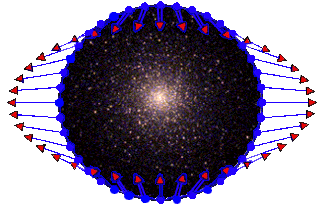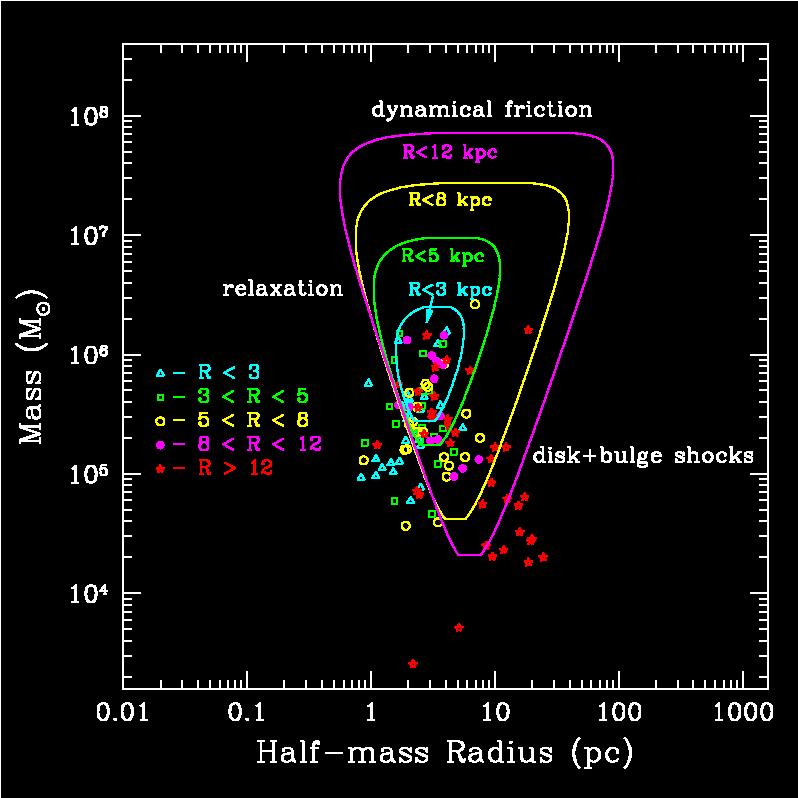Oleg Y. Gnedin
Formation and Dynamical Evolution of Globular Clusters
 Gnedin & Ostriker (1997)
To investigate the dynamical evolution of the Galactic Globular
Cluster System, we used a Fokker-Planck code which includes two-body
stellar relaxation, tidal truncation of the clusters, compressive
gravitational shocks during the passage through the Galactic disk, and
the tidal shock perturbations near the Galactic bulge. The results
suggest that more than half of the present sample of globular clusters
will be destroyed within the next Hubble time. The destruction rate
varies from 52% to 86% depending on the Galactic model.
Gnedin & Ostriker (1997)
To investigate the dynamical evolution of the Galactic Globular
Cluster System, we used a Fokker-Planck code which includes two-body
stellar relaxation, tidal truncation of the clusters, compressive
gravitational shocks during the passage through the Galactic disk, and
the tidal shock perturbations near the Galactic bulge. The results
suggest that more than half of the present sample of globular clusters
will be destroyed within the next Hubble time. The destruction rate
varies from 52% to 86% depending on the Galactic model.
Gnedin, Hernquist & Ostriker (1999)
We derived the formalism for the tidal field exerted by a spherically
symmetric galaxy having an extended mass distribution, and calculated
tidal perturbations and heating of stars in a globular cluster or a
satellite galaxy orbiting in the external potential. Heating on
highly eccentric orbits dominates as the adiabatic corrections
strongly damp the energy change on low eccentricity orbits. The
results are illustrated for the example of globular cluster NGC 6712.
For the orbital eccentricities higher than 0.9 the future lifetime of
NGC 6712 is less than 1010 yr.
Gnedin, Lee, & Ostriker (1999)

Vital diagram of globular clusters:
Table of the Galactic globular cluster parameters
(Table 1 of Gnedin & Ostriker 1997)
Table of the destruction times for globular clusters
(Table 3 of Gnedin & Ostriker 1997)
Gnedin (1997)
For the three best studied systems, in the Milky Way, M31, and M87,
there is a statistically significant difference between the inner and
outer populations of globular clusters. In all cases the inner
clusters are on average brighter than the outer clusters (0.24 <
 m0 < 0.79) and have a smaller
dispersion in magnitudes (0.09 <
m0 < 0.79) and have a smaller
dispersion in magnitudes (0.09 < 
 < 0.61). The differences are of the type that would be expected if
the inner population had been depleted by tidal shocks.
< 0.61). The differences are of the type that would be expected if
the inner population had been depleted by tidal shocks.
Ostriker & Gnedin (1997)
Assuming that the initial Globular Cluster
Luminosity Function (GCLF) was identical in all galaxies, we can
correct the observed GCLF for dynamical evolution and use it as a
distance indicator. This new method gives
dmM31 = 24.03 ± 0.23,
dmM87 = 30.81 ± 0.17.
Kravtsov & Gnedin (2003)
We study the formation of globular clusters (GCs) in a Milky Way-size
galaxy using a high-resolution cosmological simulation. The clusters
in our model form in the strongly baryon-dominated cores of supergiant
molecular clouds in the gaseous disks of high-redshift galaxies. The
properties of clusters are estimated using a physically-motivated
subgrid model of the isothermal cloud collapse. The first clusters in
the simulation form at z~12, while the best conditions for GC
formation appear to be at z~3-5. Most clusters form in the progenitor
galaxies of the virial mass >10^9 Msun and the total mass of the
cluster population is strongly correlated with the mass of its host
galaxy with a fraction ~2x10^-4 of the galactic baryons being in the
form of GCs. In addition, the mass of the GC population and the
maximum cluster mass in a given region strongly correlate with the
local average star formation rate. We find that the mass, size, and
metallicity distributions of the cluster population identified in the
simulation are remarkably similar to the corresponding distributions
of the Milky Way globulars. We find no clear mass-metallicity or
age-metallicity correlations for the old clusters. The zero-age
cluster mass function can be approximated by a power-law,
dN/dM~M^-alpha, with alpha~2, in agreement with the mass function of
young stellar clusters in starbursting galaxies. However, the shape of
the zero-age mass function may be better described by the high-mass
tail of a lognormal distribution which peaks at \~10^3 Msun. We
discuss in detail the origin, universality, and dynamical evolution of
the globular cluster mass function. Our results indicate that globular
clusters with properties similar to those of observed clusters can
form naturally within young dense gaseous disks at z>~3 in the LCDM
cosmology.
Gnedin et al. (2002)
Using current observational data and simple dynamical modeling, we
demonstrate that
 Cen
is not special among the Galactic globular clusters in its ability to
produce and retain the heavy elements dispersed in the AGB phase of
stellar evolution. Multiple stellar populations, observed in
Cen
is not special among the Galactic globular clusters in its ability to
produce and retain the heavy elements dispersed in the AGB phase of
stellar evolution. Multiple stellar populations, observed in
 Cen,
cannot be explained if it had formed as an isolated star cluster. The
formation within a progenitor galaxy of the Milky Way is more likely,
although the unique properties of
Cen,
cannot be explained if it had formed as an isolated star cluster. The
formation within a progenitor galaxy of the Milky Way is more likely,
although the unique properties of
 Cen
still remain a mystery.
Cen
still remain a mystery.
Table of the escape velocity and velocity dispersion
from the photometric models
Table of the central velocity dispersion of
the Galactic globular clusters
(Table 2 of Pryor & Meylan 1993)
Table of main-sequence lifetimes for the
low-metallicity AGB stars
ALSO:
Data on Galactic Globular Clusters compiled by
George Djorgovski
Catalogue of Milky Way Globular Cluster Parameters
compiled by
Bill Harris
Extragalactic Globular Cluster Systems review by Harris
N-body models of star clusters by Manybody.org
Gaseous models of star clusters
Starburst 99 model
Star Clusters Young & Old Newsletter
The Local Group by Lucio Mayer
Last modified: November 20, 2003
 Gnedin & Ostriker (1997)
To investigate the dynamical evolution of the Galactic Globular
Cluster System, we used a Fokker-Planck code which includes two-body
stellar relaxation, tidal truncation of the clusters, compressive
gravitational shocks during the passage through the Galactic disk, and
the tidal shock perturbations near the Galactic bulge. The results
suggest that more than half of the present sample of globular clusters
will be destroyed within the next Hubble time. The destruction rate
varies from 52% to 86% depending on the Galactic model.
Gnedin & Ostriker (1997)
To investigate the dynamical evolution of the Galactic Globular
Cluster System, we used a Fokker-Planck code which includes two-body
stellar relaxation, tidal truncation of the clusters, compressive
gravitational shocks during the passage through the Galactic disk, and
the tidal shock perturbations near the Galactic bulge. The results
suggest that more than half of the present sample of globular clusters
will be destroyed within the next Hubble time. The destruction rate
varies from 52% to 86% depending on the Galactic model.
